I know most CEOs do not want a lecture on meta tags. You want pipeline that does not spike and crash, revenue you can forecast, and a lead cost that keeps margins healthy. That is exactly where B2B SEO for service companies earns its keep. Done right, it becomes a quiet engine that captures high-intent demand, turns qualified traffic into sales-qualified leads (SQLs), and supports longer sales cycles without leaning on ever-rising ad spend. It is not magic. It is discipline, clarity on what matters, and a tight link between search, content, and sales data.
Why B2B SEO for service companies matters
If a channel cannot contribute to revenue, it is noise. I invest in B2B SEO because it compounds pipeline while lowering blended customer acquisition cost (CAC). It is one of the few channels that improves with age. Early sprints yield quick wins; ongoing work creates durable advantages - rankings for the queries that drive demos, not vanity traffic. And unlike paid, you do not pay for every click forever.
I keep timelines realistic because expectations decide satisfaction:
- Quick wins in 30-60 days: refresh high-potential pages, fix conversion friction, strengthen internal links, and surface proof on bottom-of-funnel (BOFU) pages. You will see more qualified demo requests even if rankings barely move.
- Compounding gains in 3-6 months: expand into demand-capture topics tied to services and industries, deepen content quality, and earn credible links. Rankings, click-through rate (CTR), and SQL volume start to trend up together.
Accountability is non-negotiable. I report weekly on leading indicators and monthly on revenue contribution.
- Leading indicators: indexed pages, keyword footprints for BOFU terms, CTR by page, lead quality, form conversion rate, demo requests.
- Lagging indicators: SQLs and opportunities from organic, weighted pipeline, and closed revenue attribution.
Simple ROI timeline, no fluff:
- Month 0: Baseline set, fixes started
- Month 1: Content refreshes and conversion improvements - lift in form fills and demo bookings
- Month 2: BOFU pages live, internal links added - higher CTR, first SQL gains
- Month 3: New demand-capture topics live - pipeline contribution starts to show
- Months 4-6: Rankings firm up - steady SQLs, improved CAC payback, revenue attribution
Case-style proof points:
- SaaS implementation partner, 40-person team: refreshed 12 service and industry pages, added case proof and FAQs, and fixed form UX. In 45 days, demo conversions rose 38 percent and SQLs from organic climbed 26 percent without net-new content.
- Managed IT provider: launched 8 BOFU pages and a comparison guide cluster. Within 4 months, organic pipeline reached 31 percent of total pipeline and reduced blended CAC by 19 percent.
Yes, SEO takes time. But the first levers hit in weeks, not years.
What is B2B SEO for service companies
B2B SEO is the practice of earning visibility on searches tied to real buyer intent across longer, multi-stakeholder sales cycles. That means aligning pages with solution-aware and problem-aware queries, handling technical quality, and weaving social proof and clarity into every conversion path. It is less about traffic totals and more about fit and stage.
B2B vs. B2C behavior is not subtle. B2C clicks, compares, and buys. B2B researches, shares links internally, loops in finance, books a call, and needs proof it will work in their context. So the conversion path is demo or consult, not cart. That changes what you publish and how you measure success.
Map the search engine results page (SERP) to the funnel:
- Bottom of funnel (selection): service pages by use case and industry, comparison pages, pricing primers, implementation or migration pages, ROI pages, and case libraries.
- Middle of funnel (evaluation): buying guides, integration walkthroughs, playbooks, and checklists written for evaluators and influencers.
- Top of funnel (problem framing): explainers and frameworks tied to your core services, not random topics.
A mini buyer journey aligned to search intent:
- Trigger - Problem aware - Solution aware - Vendor aware - Selection
- SERP fit: TOFU guides - MOFU guides - BOFU services - BOFU with proof
- Primary CTA: scroll depth or optional email capture - demo request - calendar booking
My aim is simple to say and hard to miss: match each stage with a page that answers the next question the buyer will ask.
B2B SEO: Getting started
You do not need a tech stack arms race to start. You need clarity, ownership, and a 90-day plan that stacks quick wins with long-term moves.
Kickoff steps that matter:
-
Align ideal customer profile (ICP) and services to search intent
- List core services and your top ICPs with their pains, terms they use, and decision triggers.
- Map to queries buyers actually type using your search performance data and sales notes to get language right.
-
Run a baseline audit
- Technical: crawl key templates, fix indexation issues, thin content, slow pages, and broken internal links.
- Content: find pages with impressions and low CTR, pages with traffic but weak conversion, and gaps at BOFU.
- Authority: collect link-worthy assets you already have, like original data, calculators, or standout case stories.
-
Build a demand-capture keyword set
- Focus on intent that books calls. Variations like service name plus industry, location, integration, migration, pricing, ROI, and comparison.
-
Prioritize BOFU pages
- Create or refresh service and industry pages first. Add proof, FAQs, process visuals, integration details, and clear CTAs.
-
Draft content briefs and an internal linking plan
- Each brief includes search intent, structure, required proof, and two to four internal links from related pages.
-
Measurement setup
- Configure conversions in your analytics platform, track queries and CTR in your search tool, and connect CRM attribution with consistent UTM parameters and hidden fields. Tie paid and organic touchpoints to the same opportunity object so finance trusts the numbers.
Ownership model:
- CEO: sets the north-star metric, removes blockers, expects accountability.
- Head of Marketing: owns the plan and weekly reporting.
- SEO lead: drives research, briefs, and prioritization.
- Content lead or writer: ships drafts and updates.
- Developer: handles fixes, structured data, and speed.
- Sales operations: validates attribution in the CRM and defines SQL criteria.
A 90-day plan by week:
- Weeks 1-2: baseline audit, ICP and service-to-intent mapping, tracking and CRM checks, quick technical fixes.
- Weeks 3-4: refresh top 6-10 pages with traffic but weak conversion, fix forms and UX, publish missing FAQs and case snippets.
- Weeks 5-6: publish or overhaul 4-6 BOFU pages for top ICPs and industries; add internal links from legacy pages.
- Weeks 7-8: create 2-3 MOFU guides that directly support those BOFU pages; begin outreach for links to your strongest asset.
- Weeks 9-10: test on-page elements like headlines and CTAs; ship one comparison page and one pricing primer.
- Weeks 11-12: review performance, expand the keyword set, and plan next quarter based on what drove SQLs and opportunities.
Dashboards I keep simple:
- Executive snapshot (weekly): organic demo requests; SQLs from organic; pipeline created from organic (this quarter); CAC payback trend.
- Operations view (weekly): CTR by top BOFU pages; form conversion rate by page; time on page and scroll depth from behavior analytics; new vs. returning demo requests.
- Search view (monthly): rankings for service plus industry terms; clicks and impressions for BOFU pages; link growth to priority pages.
Revenue-led SEO
Old mindset: traffic at all costs. New mindset: revenue or it does not count. My north star is pipeline or revenue from organic, not pageviews. Leading indicators are qualified demo requests, SQLs, and opportunities - the steps that correlate with bookings.
Set OKRs that make sense:
- Objective: grow pipeline from organic by 30 percent next quarter.
- Key results:
- Publish 6 BOFU pages for services and industries that match current ICPs.
- Lift organic form conversion rate from 1.2 percent to 2.0 percent.
- Increase SQLs from organic by 20 percent.
- Raise CTR on the top 10 pages from 2.5 percent to 4.0 percent.
Keep a simple scorecard:
- Page: Managed SOC for Healthcare - intent: industry + service, high intent - target: 10 SQLs per month from organic - maintenance: update proof quarterly, monitor CTR weekly.
- Page: Salesforce Integration Services - intent: integration + migration, high intent - target: 8 SQLs per month and 2 opportunities - maintenance: add a new case summary each month, test H1 variants.
Traffic is useful only when it moves the scorecard.
SEO strategy types
I pick a primary lane based on goals and timeline. Blending is fine, but leading with one keeps resources from scattering.
-
Demand capture
- When to use: you sell services buyers already search for.
- Pros: faster path to SQLs, easier to measure.
- Cons: competitive; needs content quality and links.
- Example pages: service + industry, migration, integration, comparison, ROI explainer.
-
Demand creation
- When to use: you are early in a category or need to shape the problem.
- Pros: builds authority and brand.
- Cons: slower to revenue.
- Example pages: frameworks, playbooks, research that carry a clear point of view.
-
Net-new logo vs. expansion or account-based marketing (ABM)
- Net-new: topics that attract first-time evaluators.
- Expansion: content for existing clients and cross-sell, like add-on services and health checks.
- ABM: industry-specific pages and case libraries that match target accounts.
-
Evergreen vs. topical
- Evergreen: stable search volume and ongoing value.
- Topical: seasonal needs like budget planning or compliance deadlines; use to gain links and awareness, then pass authority to evergreen.
-
National vs. local
- National: broader reach, higher competition.
- Local: faster wins if buyers seek proximity or compliance expertise; build location pages with real team and proof.
A quick decision path:
- If your category is known, start with demand capture and BOFU first.
- If your category is nascent, start with demand creation and pain-first MOFU guides.
- If buyers need local help, add location pages with proof.
- If you sell to current clients too, add an expansion cluster.
Lead scoring
Traffic can look great and still waste your sales team’s time. I treat scoring as the judge of quality for SEO.
Define what a qualified lead looks like:
- Firmographics: company size, industry, tech stack, region.
- Intent: pages viewed, recency, and depth of engagement.
- Stage: did they view BOFU pages like services, pricing, or comparison before requesting a demo?
MQL vs. SQL, clear and simple:
- Marketing-qualified lead (MQL): meets basic fit and shows intent signals like viewing two BOFU pages and a case study.
- Sales-qualified lead (SQL): sales confirms fit and books a call or marks as opportunity-ready.
Build the feedback loop with sales:
- Tag all organic form fills with source and landing page URL.
- Attach touchpoints to the contact and opportunity, not just the lead.
- Each week, review the last 20 organic leads with sales: which industries said yes, which pages showed up before booking. Tighten content and targeting based on that.
A qualifying rubric to start:
- +10 points: viewed 2+ BOFU pages in a session
- +15 points: viewed pricing or comparison
- +10 points: company size in ICP range
- +10 points: ICP industry
- +5 points: integration page viewed that matches your core stack
- -10 points: student or free email domain
- SQL threshold: 35+ points plus manual check by sales
How to tag and attribute:
- Use consistent UTM parameters on internal CTAs and navigation experiments; capture them with hidden fields.
- Send pageview history to the CRM.
- Attribute pipeline to organic when an organic session was part of the path and the landing page matched the SEO plan. Avoid last-touch only.
SEO measurement
I measure in two modes that mirror software testing.
Offline measurement before launch:
- Forecast by page: traffic potential, click-through odds, difficulty, and expected conversion rate based on similar pages - kept conservative.
- Content QA: intent match, structure, proof density, internal links, and schema. Read it out loud - would a CFO nod or frown?
- Risk checks: pages that could cannibalize each other, tech constraints, and speed on the template.
Online measurement in production:
- Live CTR by query and page.
- Rankings for BOFU head terms and long-tail variants.
- Conversion metrics: form rate, demo bookings, and qualified demo rate.
- Sales metrics: SQLs, opportunities, and pipeline created from organic.
Run tests to learn faster:
- Refresh vs. net-new: compare similar pages over a month where one gets a full refresh and the other waits.
- Content A vs. B: where possible, test headline and intro variants with server-side rules or your experimentation platform.
- Holdout cohorts: keep a small set of similar pages unchanged for a period to isolate the effect of your improvements.
Choose forecasting vs. live experiments wisely:
- Low-risk, high-intent pages: publish fast, monitor weekly, iterate.
- High-risk or big-lift pages: do stronger offline forecast and QA, then ship with clear targets.
- Low-volume markets: rely more on lead quality and pipeline movement than rankings alone.
A simple measurement scorecard:
- By page: CTR target vs. actual; form rate target vs. actual; SQLs this month; pipeline created.
- By stage: TOFU - scroll depth and assisted conversions; MOFU - return visits and content-to-demo path; BOFU - demo requests and SQL rate.
- By ICP: sessions, demo rate, and pipeline for each ICP segment.
Helpful enablers to keep it tight:
- Research and tracking: your search performance and analytics platforms.
- Site health: a crawler and page speed testing.
- Behavior: a behavior analytics tool for scroll depth and session recordings.
- Dashboards: a BI view that blends analytics and CRM data, or a spreadsheet for the scorecard.
- CRM and attribution: one CRM with consistent UTMs and field mapping.
Final thought for the practical CEO
SEO is painted as slow when teams chase vanity traffic or ignore conversion and sales data. When I align pages with buyer intent, refresh what already ranks, and keep score by SQLs and pipeline, I get a channel that compounds. It is steady. It is measurable. And it delivers something paid channels cannot defend for long: durable visibility where the best buyers start their research.
The play is simple: put bottom-of-funnel first, make measurement unskippable, and treat lead quality as the judge. Do that, and B2B SEO for service companies shifts from a cost center to a growth asset that keeps paying back.

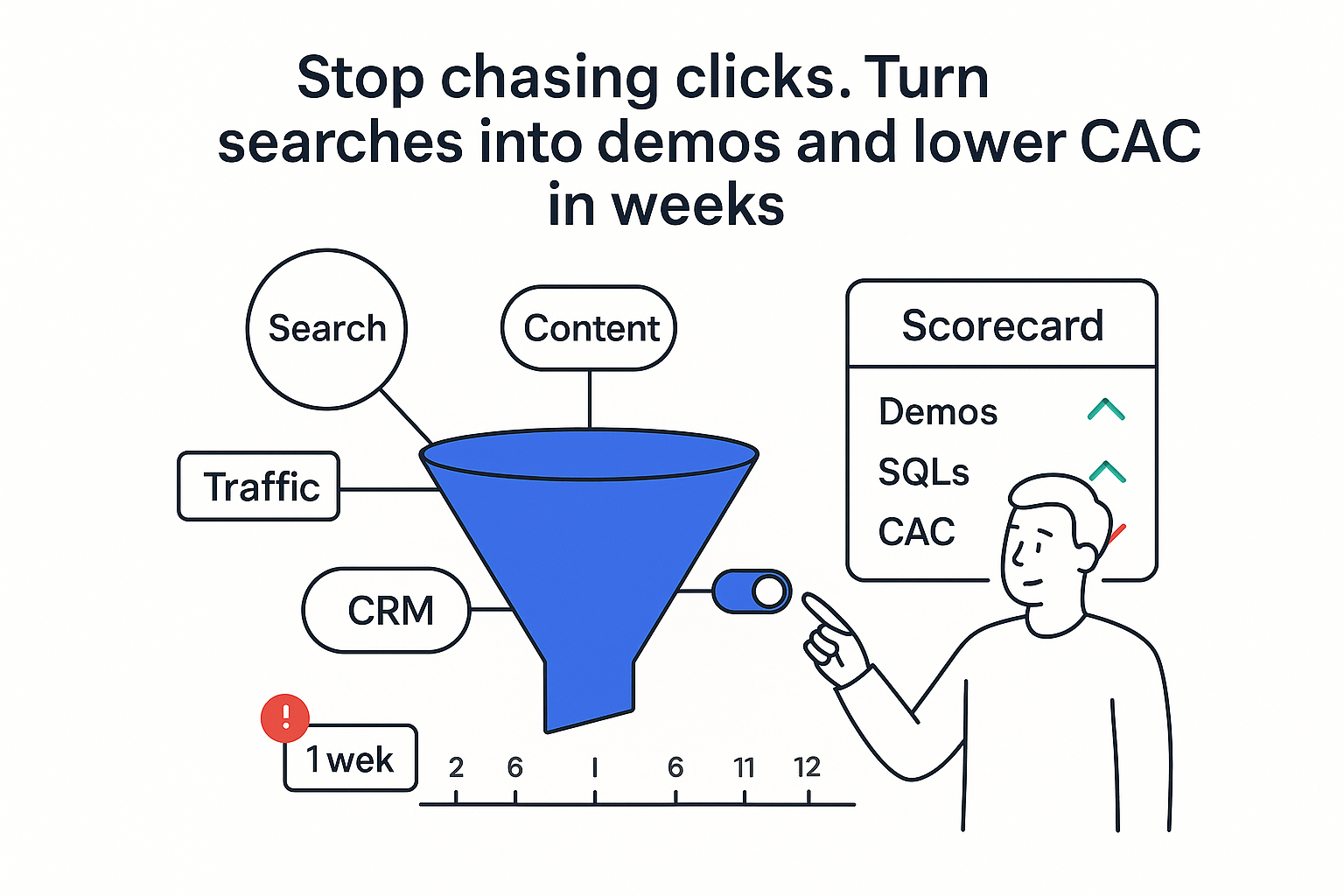

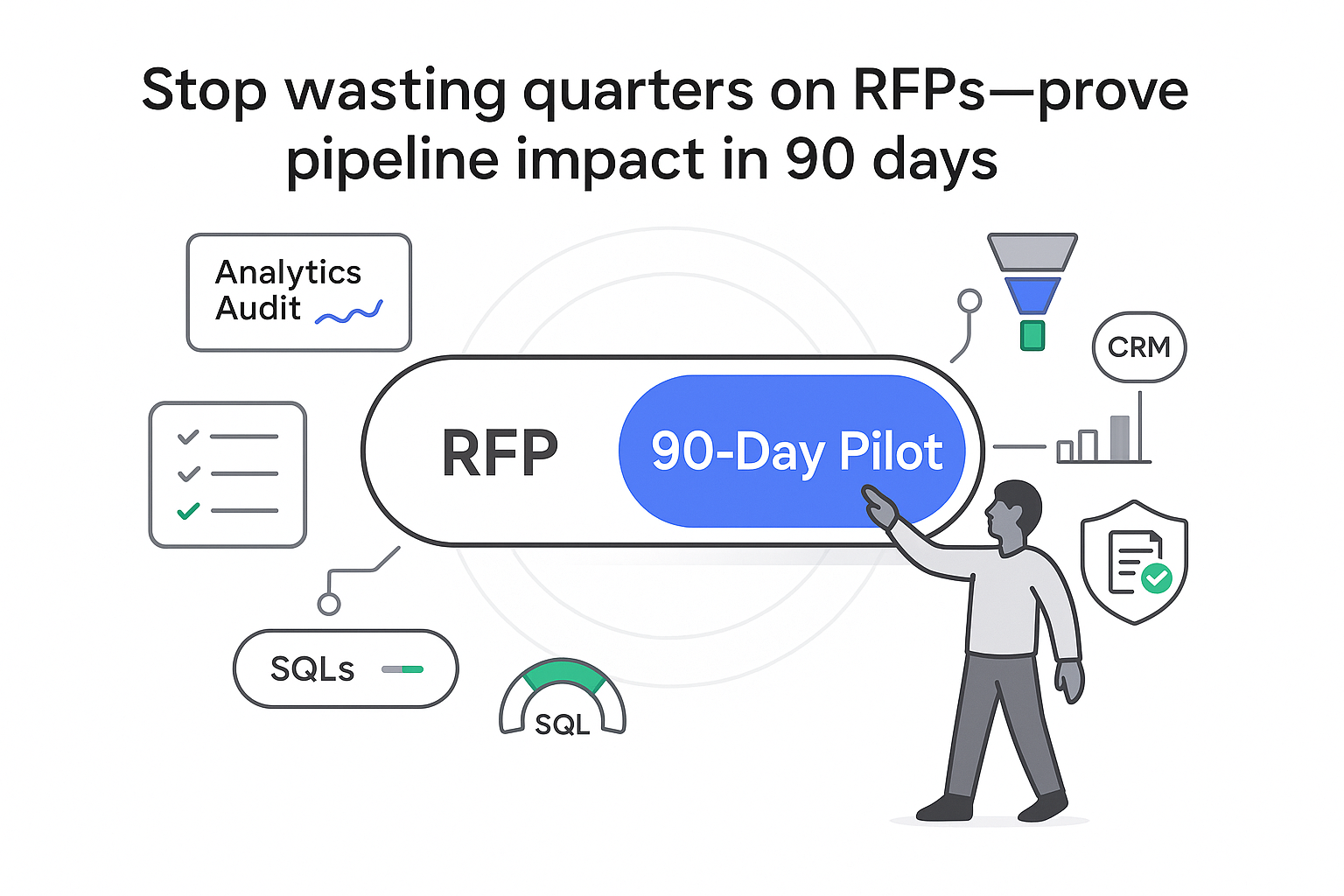
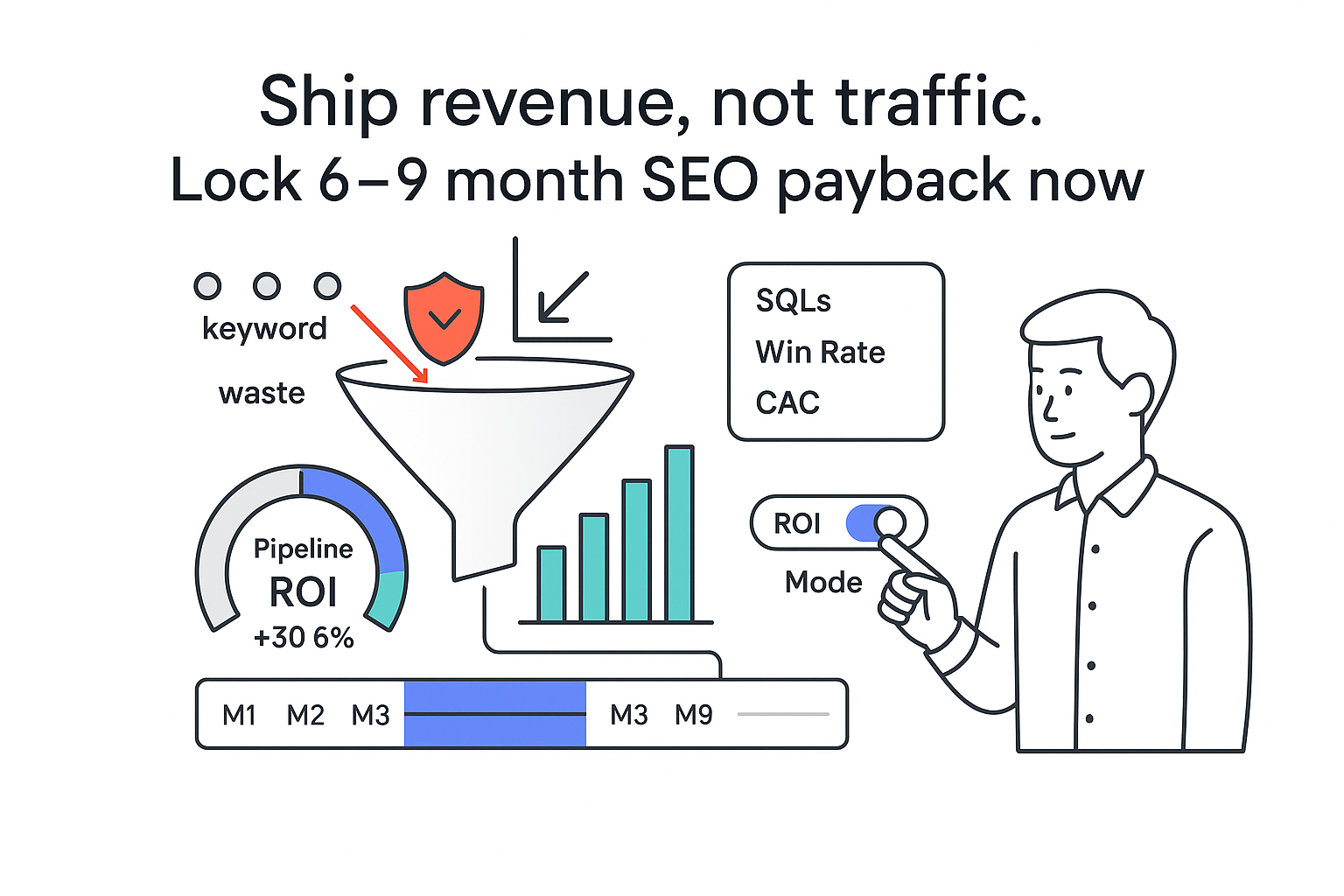
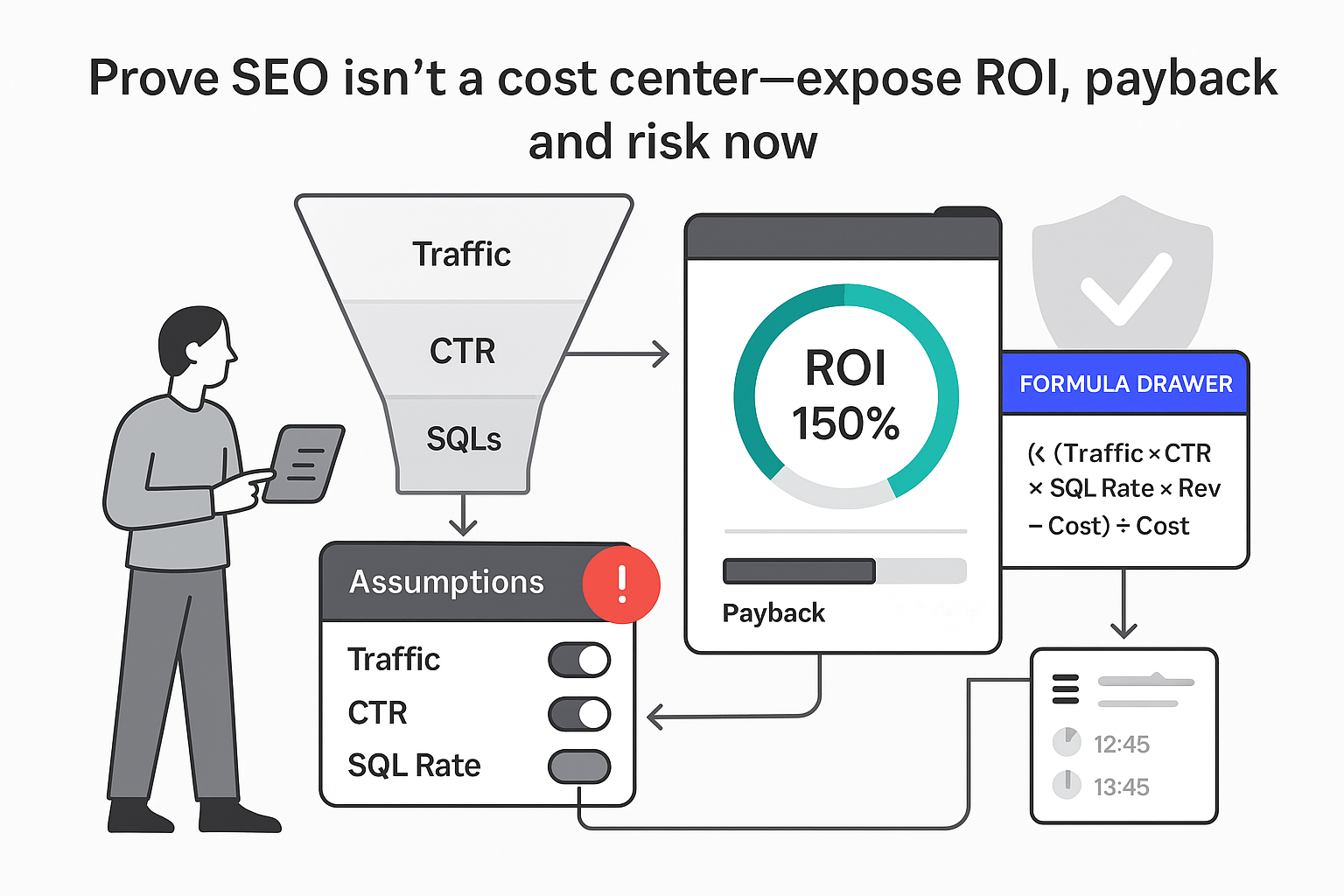
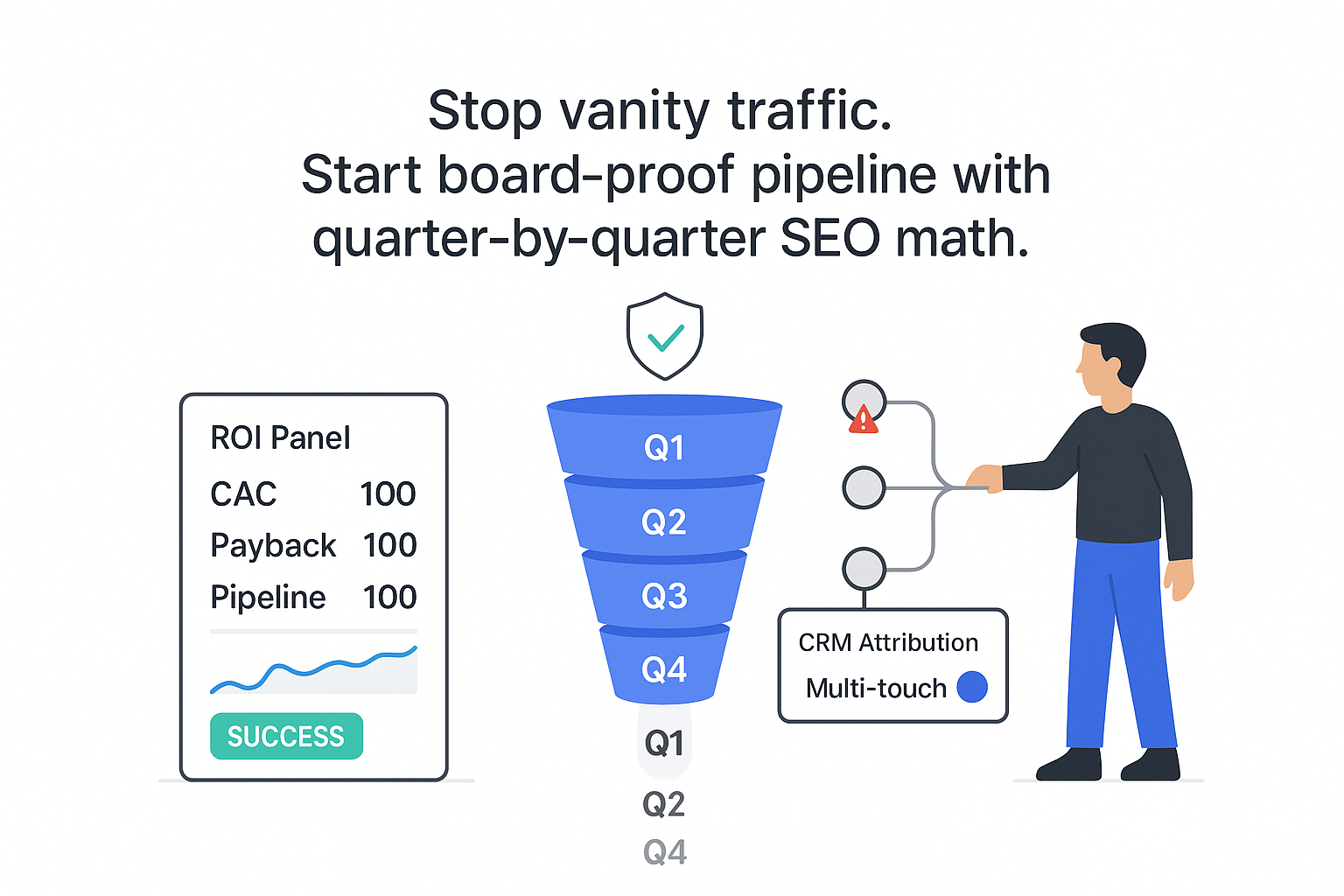
.svg)